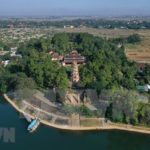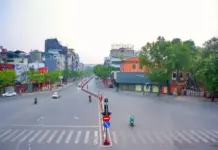Every resident of Hanoi has their own memories of the sidewalk, both joyful and challenging. However, the origins of the city’s sidewalks are not widely known.
The History of Hanoi Sidewalks

A street vendor on Hang Dao Street in 1940. Photo: Harrison Forman/ Kinh te & Do thi
According to historian Nguyen Ngoc Tien, Hanoi’s pavements were few and far between between 1847 and 1883. These were mainly located in areas with a high Chinese population, such as Phuc Kien (now Lan Ong Street), Quan Co Den (now Ma May Street), and Hang Ngang. The majority of the city’s streets remained unpaved.
The “36 streets” commercial district lacked sidewalks and drainage channels. Whenever it rained, the streets would be submerged under several centimeters of water, causing carriage drivers to warn pedestrians by ringing bells so they could avoid getting splashed with mud.
In 1883, Hanoi’s Police Commissioner and Governor Nguyen Huu Do decided to use broken tiles to pave some of the streets. That same year, Hanoi’s first French Resident Superior, Bonnal, implemented street renovation measures.

Hanoi’s Old Quarter Area in 1941. Photo: Milwaukee Library at Wisconsin University, United State/ Hanoi Library
Under Bonnal’s leadership, the Sword Lake area was reorganized. Roads surrounding the lake were developed, thoroughfares connecting the Don Thuy concession area with the Old Quarter were widened, and a French quarter was established east and south of Sword Lake. By the end of 1885, the reformation of Hang Kham Street (now Trang Tien and Hang Khay Streets) was completed.
Hang Kham Street was widened and paved with tar, while sidewalks were built on both sides. Phoenix flower trees were planted along the sidewalks to provide shade during the summer. Hang Kham’s sidewalks were the first Western-style sidewalks in Hanoi.

During the period of American air raids on Northern Vietnam, Hanoi’s sidewalks took on a new role. Personal air raid shelters, concrete tubes measuring six to eight square meters, were constructed beneath the sidewalks for people to seek shelter when they heard the sirens atop the Grand Opera House.
According to Hanoi researcher Dinh Dong Ha, around August 5, 1964, the United States launched its first air raids in the North. As a result, Hanoians were evacuated to other areas, leaving behind a deserted city with paper notes attached to house doors for passing soldiers or workers. These notes indicated that the keys were being held by the neighborhood leader or another designated person.
The famous German photographer Thomas Billhardt captured numerous images of Hanoi’s streets during this era, including the iconic photograph of four children peeking out of a bomb shelter on the sidewalk of the Metropole hotel in 1967.

Hanoians were in bomb shelters in front of the Metropole Hotel in 1967. Photo: Lee Lockwood/ kienthuc.net.vn
The book “History of the Party Committee of Hanoi 1930-2000” (Hanoi Publishing House) states that during the American War, bomb shelters were dug along all streets and beneath every house in Hanoi. It is estimated that 40,000 individual bomb shelters and 9,000 collective bunkers, capable of accommodating 90,000 people, were constructed during the war.
All streets in Hanoi’s city center had personal bomb shelters. These pits were dug straight down into the sidewalk and were large enough to accommodate a single person. Individual bunkers made of coal slag and topped with straw were placed every 20 meters on either side of the sidewalk. These bunkers effectively protected people from shrapnel.
Hanoi also had a unique bomb shelter partially underground in what is now Ly Thai To Flower Garden. This spacious cellar could house dozens of people and had an entrance in the shape of an octagonal house. Today, trees and buildings have grown above the basement.
With the signing of the Paris Peace Accords in 1973 and the subsequent withdrawal of American troops, peace was restored in North Vietnam, and the bomb shelters were filled in.
.jpg)

Images before 1975: Public water dispensers on Hanoi’s sidewalk. Hanoi in the 1990s. Photo: Thomas Billhardt
Con Co Island sees tourism boom
Con Co Island in the central province of Quang Tri is seeing a boom in tourist arrival since the first visitors set foot on the island in a tour launched two years ago.
A Glimpse of Hanoi’s Old Quarter
Recently, the Management Board of Hanoi’s Old Quarter cooperated with the city of Toulouse to open an exhibition named “Ke cho – Pho co” (City Dwellers – Old Quarter) at Hanoi’s Old Quarter Cultural Exchange Centre to depict the formation and development of Hanoi’s Old Quarter in the past 1000 years.








